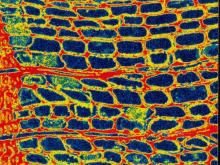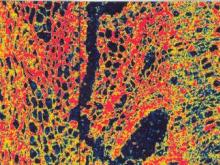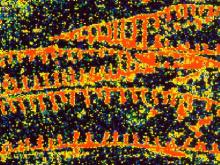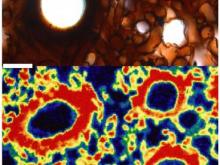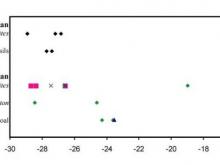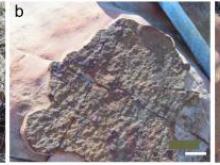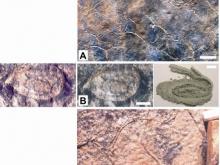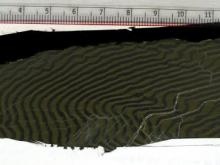Paleontology
In the summer of 1997, at the Gordon Research Conference on the Origin of Life, Hazen got into a conversation with Harvard University paleontologist Andy Knoll about how standard analytical techniques of mineralogy might be applied to the study of fossils. That conversation led to a series of collaborations with Knoll’s students. Hazen's first efforts were simply to map fossil carbon in plant fossils, such as ancient wood and a variety of species from the famed Rhynie Chert of Scotland. Kevin Boyce worked at the Geophysical Lab with Marilyn Fogel on isotopes and with George Cody on x-ray microscopy as well. Hazen has subsequently worked with Nora Noffke (Old Dominion University) on a variety of Archean samples with evidence of ancient microbial mats.
RESEARCH WITH KEVIN BOYCE (UNIVERSITY OF CHICAGO and currently at STANFORD UNIVERSITY)
Early wood fossils show cellular structures. These were Hazen and Boyce's first tests of electron microprobe analysis of carbon in ancient fossils. In these maps red indicates the highest concentration of carbon. See Boyce CK, Hazen RM and Knoll AH (2001) Nondestructive, in situ, cellular-scale mapping of elemental abundances including organic carbon in permineralized fossils. Proceedings of the National Academy of Sciences (US), 98:5970-5974
Rhynie Chert
From the abstract Boyce CK, Cody GD, Fogel ML, Hazen RM, Alexander CMO’D and Knoll AH (2003) Chemical evidence for cell wall lignifications and the evolution of tracheids in early Devonian plants. International Journal of Plant Science 164:691-702 “Anatomically preserved land plant fossils from the Lower Devonian Rhynie Chert contain conducting tissues with cells that range from dark colored, elongated cells without secondary wall thickenings to tracheids similar to those of extant tracheophytes. A suite of tissue-specific microanalytical techniques was used to assess lignification in fossils of Aglaophyton, Rhynia, and Asteroxylon. Isotope ratio mass spectrometry provides millimeter-scale resolution of carbon isotopic abundances, whereas soft X-ray carbon (1s) spectromicroscopy provides micron-scale resolution of the preservation of organic molecular functionality. The isotopic and organic chemistry of Rhynie Chert plants suggests that the earliest vascular thickenings were probably unlignified and that cell wall lignification may have first appeared in the outer cortex. Only later, it seems, was lignin deposited in conducting cells to produce the true tracheids seen today in vascular plants.”
Prototaxites
“The enigmatic Paleozoic fossil Prototaxites Dawson 1859 consists of tree-like trunks as long as 8 m constructed of interwoven tubes <50 mm in diameter. Prototaxites specimens from five localities differ from contemporaneous vascular plants by exhibiting a carbon isotopic range, within and between localities, of as much as 13‰ δ13C. Pyrolysis–gas chromatography–mass spectrometry highlights compositional differences between Prototaxites and co-occurring plant fossils and supports interpretation of isotopic distinctions as biological rather than diagenetic in origin. Such a large isotopic range is difficult to reconcile with an autotrophic metabolism, suggesting instead that, consistent with anatomy-based interpretation as a fungus, Prototaxites was a heterotroph that lived on isotopically heterogeneous substrates. Light isotopic values of Prototaxites approximate those of vascular plants from the same localities; in contrast, heavy extremes seen in the Lower Devonian appear to reflect consumption of primary producers with carbon-concentrating mechanisms, such as cryptobiotic soil crusts, or possibly bryophytes. Prototaxites biogeochemistry thus suggests that a biologically heterogeneous mosaic of primary producers characterized land surfaces well into the vascular plant era.” Abstract from Boyce CK, Hotton CL, Fogel ML, Cody GD, Hazen RM and Knoll AH (2007) Devonian landscape heterogeneity recorded by a giant fungus. Geology 35(5):399-402
RESEARCH WITH NORA NOFFKE (OLD DOMINION UNIVERSITY) ON ANCIENT MICROBIAL MATS EOZOONS????
OK, so here’s an enigma. Does anybody have any information on so-called “eozoons” from the Precambrian Belt Formation? Here’s a description of a recent find of enigmatic carbonate rocks from the Langel Ranch, Manhattan, Montana. On August 13, 2007, Hazen had the opportunity to examine briefly a carbonate outcrop near the banks of the Gallatin River, located just below the home of Tom and DeeAnn Langel on their ranch in Manhattan, Montana. The outcrop represents approximately 8 meters in vertical section, and perhaps 10 meters in lateral extent. Outcrop and hand specimens feature two interleaved lithologies – a blue-grey limestone and a buff chert – that form a variety of unusual patterns, as illustrated below. By the way, Hazen's hunch is that these rocks represent some kind of physical separation of immiscible fluids – one aqueous and carbonated, the other siliceous and oil-rich. But if anyone knows, please let him know!
Noffke has pioneered the study of Archean microbially induced sedimentary structures (MISS), such as wrinkle textures, roll-up features, filamentous mat-like structures, and distinctive binding and trapping of sedimentary grains.
See these publications for further information:
Noffke N, Beukes N, Bower D, Hazen RM and Swift D (2008) An actualistic perspective into Archean worlds – (cyano-)bacterially induced sedimentary structures in the siliciclastic Nhlazatse Section, 2.9 Ga Pongola Supergroup, South Africa. Geobiology 6(1):5-20
Noffke N, Beukes N, Gutzmer J and Hazen RM (2006) Spatial and temporal distribution of microbially induced sedimentary structures: a case study from siliciclastic storm deposits of the 2.9 Ga Witwatersrand Supergroup, South Africa. Precambrian Research 146:35-44
Noffke N, Eriksson KA, Hazen RM and Simpson EL (2006) A new window into Early Archean life:microbial mats in Earth's oldest siliciclastic tidal deposits (3.2 Ga Moodies Group, South Africa). Geology 34(4):253-256
Noffke N, Nhleko N and Hazen RM (2003) Earth’s earliest microbial mats in a siliciclastic marine environment (2.9 Ga Mozaan Group, South Africa). Geology 31(8): 673-677
RESEARCH ON DOUSHANTO, CHINA, PHOSPHATIC MICROFOSSILS WITH SHUIHAI XIAO (VIRGINIA TECH)
Summer intern David Olesh from Harvard University also did research on these specimens.
EOZOONS????
OK, so here’s an enigma. Does anybody have any information on so-called “eozoons” from the Precambrian Belt Formation? Here’s a description of a recent find of enigmatic carbonate rocks from the Langel Ranch, Manhattan, Montana. On August 13, 2007, Hazen had the opportunity to examine briefly a carbonate outcrop near the banks of the Gallatin River, located just below the home of Tom and DeeAnn Langel on their ranch in Manhattan, Montana. The outcrop represents approximately 8 meters in vertical section, and perhaps 10 meters in lateral extent. Outcrop and hand specimens feature two interleaved lithologies – a blue-grey limestone and a buff chert – that form a variety of unusual patterns, as illustrated below. By the way, Hazen's hunch is that these rocks represent some kind of physical separation of immiscible fluids – one aqueous and carbonated, the other siliceous and oil-rich. But if anyone knows, please let him know!
CALVERT COUNTY FOSSIL COLLECTING

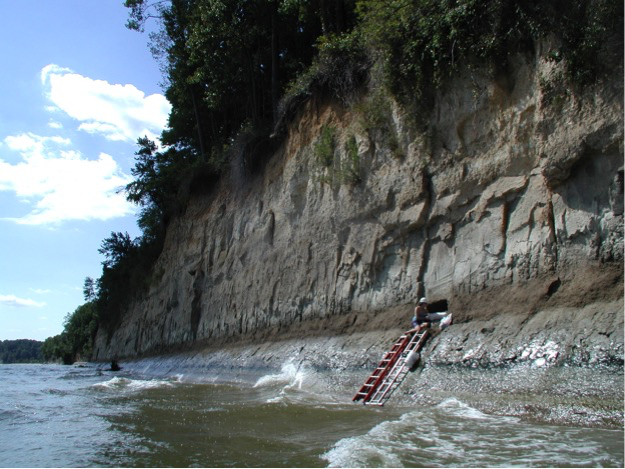
Since 1993, Bob and Margee Hazen have actively collected fossils along the Miocene cliffs of the western shore of the Chesapeake Bay. Most specimens, including molluscs and vertebrate remains, have been found in the float. They donate most of these specimens to middle school science teachers for use in classrooms. However, they have also found a few important mammal specimens, including whale, dolphin, and seal material. These specimens are donated to the Calvert Marine Museum.
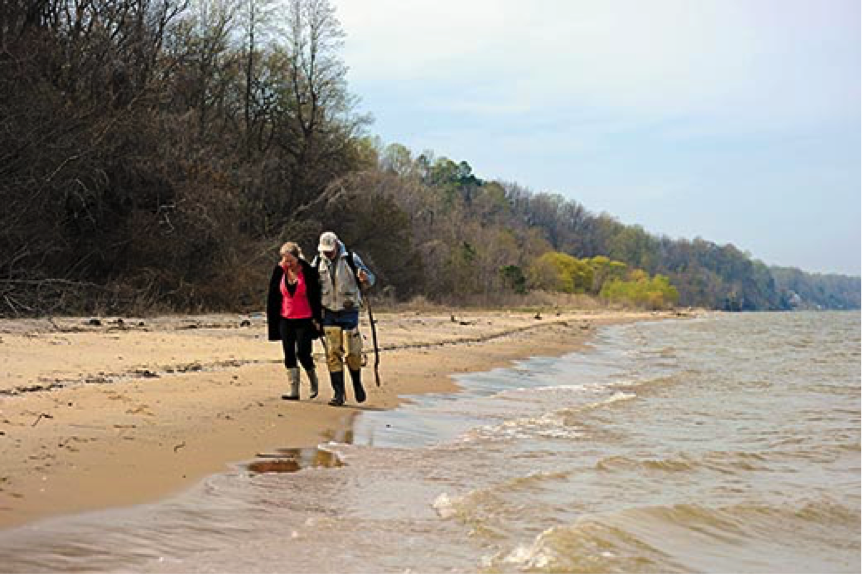
RESEARCH ON PRESERVED BIOMOLECULES IN ANCIENT MOLLUSKS
In 2012 Robert Hazen wondered why the distinctive Miocene gastropod, Ecphora (the state fossil of Maryland), is commonly colored orange brown, in contrast to almost every other mollusk that is chalky white. Working with paleobiologist John Nance of the Calvert Marine Museum, hazen and others began a study of the remarkable preservation of Miocene (15-million year old) shell-binding protein in these shells. The key to protein preservation appears to be the dense calcite shell, in sharp contrast to the more common aragonite shell mineralization of most Calvert shells. For more information see: Nance JR, Armstrong JT, Cody GD, Fogel ML and Hazen RM (2015) Preserved shell-binding protein and associated pigment in the Middle Miocene (8 to 18 Ma) gastropod Ecphora. Geochemical Perspectives Letters 1:1-8.
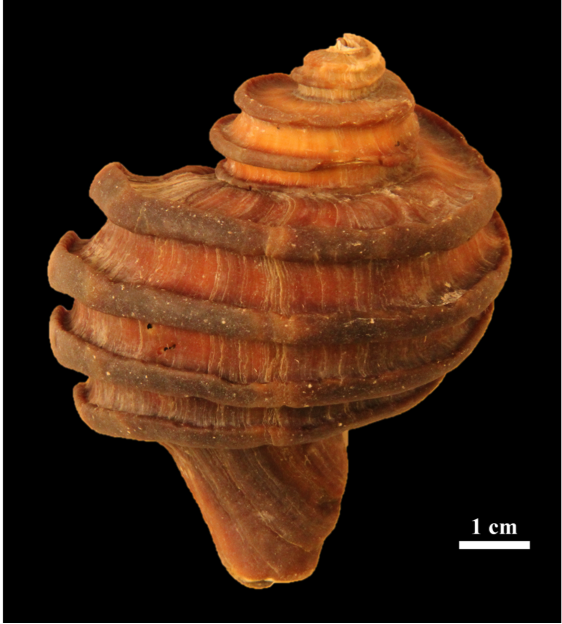
MIOCENE FOSSIL DONATIONS
Some of the fossils collected by Robert and Margaret Hazen and donated to the Calvert Marine Museum.
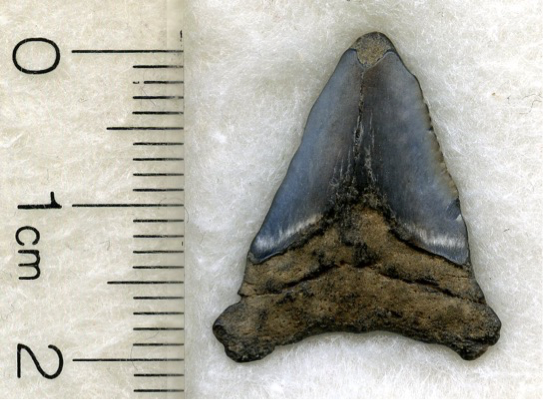
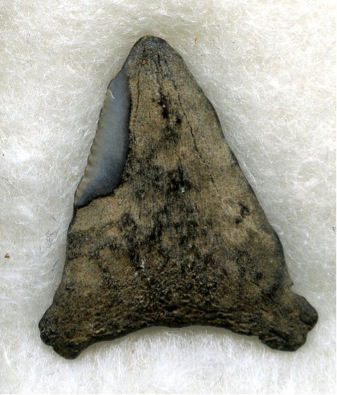
Found north of Parkers Creek in float, Summer 2009. This sample was featured in Ecphora, Volume 24, #4, page 5.


Given the freshness of this tooth, and the fact it was lying on a thin layer of sand above uppermost zone 10 pavement (which has lots of teeth in situ), the guess is that’s it’s source. This sample was featured in Ecphora, Volume 24, #4, page 4.


